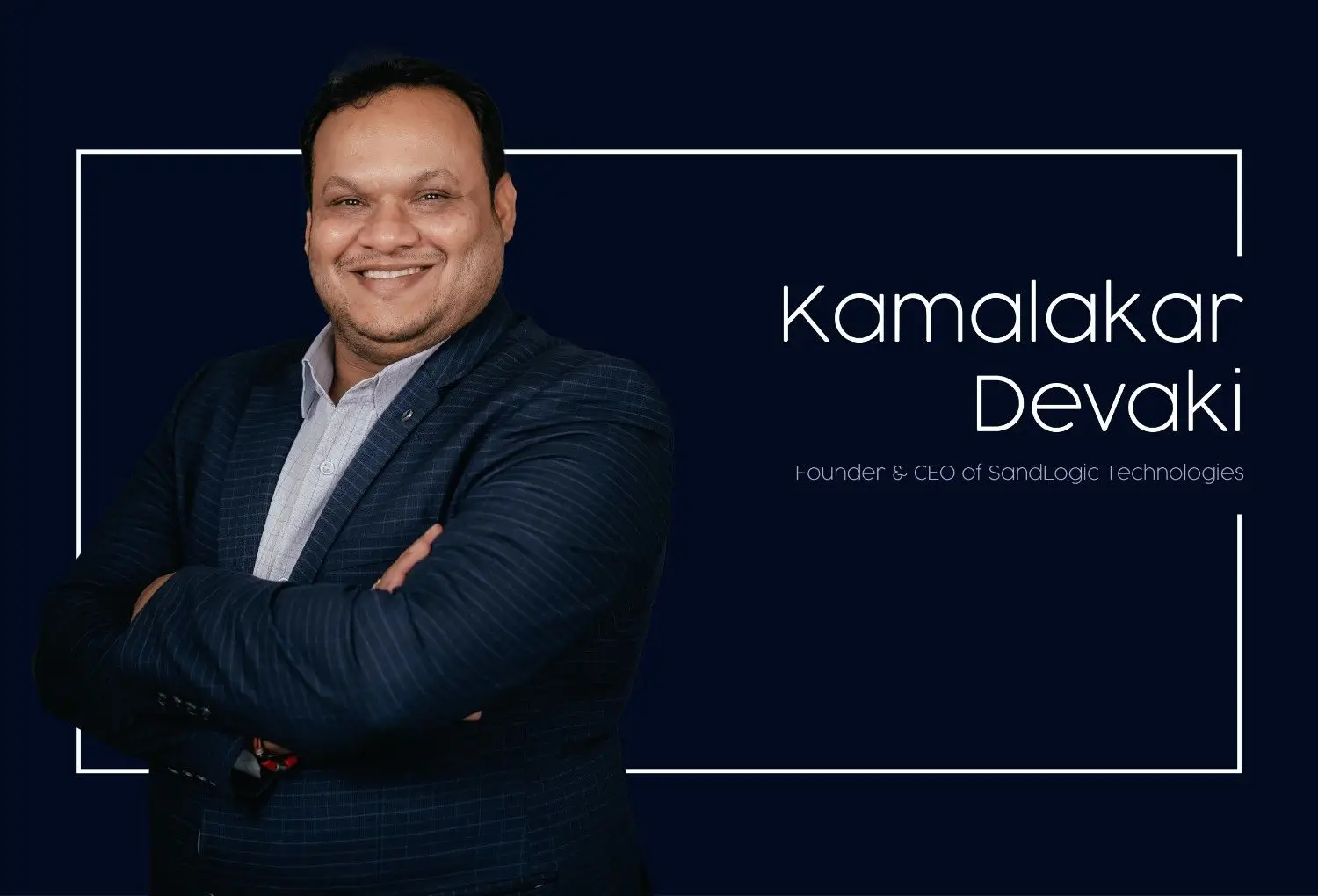Artificial intelligence isn’t just about crunching numbers or automating tasks—it’s about unlocking possibilities. Yet, for all its promise, AI remains out of reach for many businesses, tangled in high costs, rigid infrastructure, and models that fail to understand the nuances of specific industries. While tech giants race to push AI forward, a critical question remains: How do we make it practical, precise, and truly usable for those who need it most?
This is where Kamalakar Devaki steps in. Instead of chasing AI hype, he is focused on building intelligence that works in the real world—AI that understands context, minimizes hallucinations, and operates seamlessly across cloud, on-premise, and even low-power edge environments. As the Founder & CEO of SandLogic Technologies, Kamal is dismantling the barriers that keep AI locked away in research labs and turning it into a tool that businesses of all sizes can wield with confidence.
Redefining AI Accessibility and Innovation
Kamal is on a mission to redefine AI accessibility and innovation. With a deep-rooted passion for artificial intelligence and a background in software architecture, he recognized a critical gap—while AI was advancing at an unprecedented pace, its accessibility remained a challenge for enterprises requiring domain-specific intelligence. This realization sparked the creation of SandLogic Technologies, driven by the vision of “Adding Intelligence” to businesses through scalable, efficient, and adaptable AI solutions.
Kamal saw an opportunity to go beyond general-purpose AI models by developing systems that understand context, minimize hallucinations, and function seamlessly on edge devices with low power consumption. His commitment to building practical and responsible AI led to the development of groundbreaking solutions such as Shakti LLM, ExSLerate AI co-processor, and LingoForge. These innovations are designed to make AI more accessible across industries, empowering businesses to leverage the full potential of artificial intelligence without the traditional barriers.
Kamal’s journey has played a pivotal role in shaping SandLogic’s mission to make AI more accessible to businesses of all sizes. He understands that enterprises require more than just generic AI models—they need solutions that align with regulatory constraints, ensure data privacy, and provide interpretability and reliability while minimizing AI hallucinations.
Recognizing these challenges, Kamal led the development of Lingo and LingoForge, designed to help businesses train, fine-tune, and deploy large language models (LLMs) in private, on-premise, and cloud environments. These innovations enable organizations to harness the power of AI with domain-specific accuracy, operational efficiency, and seamless integration into low-power environments such as edge computing and IoT. Through this enterprise-first approach, Kamal is redefining AI adoption for businesses, ensuring it is practical, scalable, and secure.
AI for the Underdogs
Kamal recognizes that small and medium-sized enterprises (SMEs) face significant hurdles in adopting AI, including the high costs of training and deployment, a shortage of skilled AI talent for customization, concerns over data privacy with cloud-based solutions, and scalability challenges due to the high computational demands of existing AI models.
To bridge this gap, Kamal has led SandLogic in developing solutions that make AI more accessible and practical for SMEs. Lingo and LingoForge allow businesses to train AI models using their own data while maintaining security and compliance. Shakti LLM offers efficient NLP models tailored for real-time business applications, ensuring accuracy and relevance. Meanwhile, the ExSLerate AI co-processor provides a low-power AI processing alternative, reducing dependence on cloud-based infrastructure and making AI adoption more cost-effective. Through these innovations, Kamal is enabling SMEs to integrate AI seamlessly into their operations without the typical barriers, driving efficiency and growth across industries.
Kamal, has always believed that AI should be more than just a buzzword—it should be a transformative force that businesses of all sizes can harness effectively. His vision for SandLogic was born out of a realization that while AI was advancing rapidly, its accessibility remained limited, particularly for enterprises requiring domain-specific intelligence. Instead of generic, one-size-fits-all AI solutions, Kamal set out to build AI systems that truly understand context, minimize hallucinations, and operate seamlessly in real-world environments, including on edge devices with minimal power consumption.
Vision for Smarter, Secure, and Scalable Enterprise Intelligence
Under Kamal’s leadership, SandLogic has developed groundbreaking innovations like Shakti LLM, the ExSLerate AI co-processor, and LingoForge—each designed to make AI more practical, efficient, and responsible. His approach to generative AI, edge computing, and AI chip design sets him apart in the industry. Unlike traditional AI providers, Kamal’s focus has been on creating full-stack AI solutions that integrate language models, hardware acceleration, and real-time AI processing, enabling businesses to deploy AI seamlessly across cloud, edge, and on-premise infrastructures.
One of his key innovations, LingoForge, is revolutionizing the way enterprises train and fine-tune their own AI models. Kamal understood that businesses often struggle with AI solutions that lack industry-specific knowledge. To bridge this gap, he led the development of LingoForge, a self-hosted enterprise LLM authoring engine that allows companies to build domain-specific AI while maintaining full control over data privacy and security. By implementing role-based data access, organizations can ensure compliance with strict governance measures, making AI adoption more practical and responsible.
Quest to Untether Intelligence
Beyond software, Kamal has also played a pivotal role in redefining edge AI with Shakti LLMs and the ExSLerate AI chip. Unlike traditional AI models that depend heavily on cloud infrastructure, Kamal’s vision for AI extends to low-power, on-device intelligence. The ExSLerate AI co-processor, consuming less than one watt of power, is a testament to his commitment to efficiency and accessibility. This breakthrough enables AI to run on resource-constrained devices such as drones, smartwatches, and embedded systems, opening new possibilities for AI adoption in industries ranging from healthcare to industrial automation.
Kamal’s drive to make AI more adaptable is also evident in Lingo, SandLogic’s Speech, Audio, and NLP platform. Recognizing the importance of real-time insights, he spearheaded the development of Lingo to help businesses analyze conversations, detect patterns, and automate quality assessments. With multilingual capabilities that support both Indic and global languages, Lingo ensures that businesses operating in diverse markets can seamlessly process and analyze interactions in multiple languages, making AI-powered speech analytics accessible on a larger scale.
The impact of Kamal’s work extends beyond enterprise AI—his innovations are shaping the future of AI-powered automation in smart cities, healthcare IoT, and industrial robotics. The ExSLerate chip, for instance, is driving AI adoption in real-world environments where connectivity and power are limited. From AI-driven traffic management and surveillance in smart cities to real-time patient monitoring in healthcare IoT, Kamal’s work is bringing intelligence closer to the edge. His focus on low-latency AI inference has also made significant strides in autonomous systems, allowing drones, industrial robots, and smart devices to process data and make split-second decisions in real time.
A key differentiator in Kamal’s approach is his commitment to reducing AI’s dependence on cloud infrastructure. He firmly believes that for AI to be truly scalable and efficient, businesses need solutions that offer real-time processing while ensuring data privacy and security. By enabling on-device AI processing, his innovations reduce bandwidth consumption, accelerate response times, and improve operational resilience, making AI more viable for industries with limited or intermittent connectivity.
Enhancing Decision-making and Operational Efficiency
SandLogic is revolutionizing industries that depend heavily on text data processing with its advanced AI-powered platform, TXTR. Designed to extract, analyze, and leverage textual information with high precision, TXTR integrates Optical Character Recognition (OCR) and Intelligent Character Recognition (ICR) to process both printed and handwritten documents seamlessly. Unlike traditional OCR solutions, TXTR is equipped to handle multi-language, multi-format, and complex document structures, making it an ideal solution for sectors such as banking, financial services, insurance (BFSI), healthcare, and logistics.
In the BFSI sector, TXTR enhances efficiency by automating document verification, risk assessment, and fraud detection. Financial institutions often deal with high volumes of KYC (Know Your Customer) documents, loan applications, and compliance reports. By integrating AI-powered text extraction and validation, TXTR minimizes manual effort, reduces errors, and improves regulatory compliance, enabling financial enterprises to streamline operations with greater accuracy and speed.
The healthcare industry, known for its reliance on extensive documentation, benefits significantly from TXTR’s AI-powered text recognition capabilities. Medical records, prescriptions, insurance claims, and patient histories are digitized accurately, allowing healthcare providers, insurance companies, and pharmaceutical firms to optimize their workflows. With automated text extraction, hospitals and insurers can facilitate faster patient diagnoses, improve record management, and expedite insurance claim processing, ultimately enhancing decision-making and operational efficiency.
The logistics and supply chain sector, where shipment documents, invoices, and customs declarations form the backbone of operations, also sees transformative benefits from TXTR. By digitizing logistics documents in real time, the platform reduces paperwork, minimizes errors, and streamlines workflows across shipping, warehousing, and inventory management. This efficiency translates into improved accuracy in tracking and reduced operational bottlenecks, ensuring seamless coordination throughout the supply chain.
SandLogic’s Industry-backed Revolution
SandLogic’s growth and technological advancements have been significantly influenced by its participation in leading industry programs, including the Chips to Startup (C2S) initiative, the Qualcomm Mentorship Program, and the NASSCOM DeepTech Club. The C2S Program provided critical support for the development of the ExSLerate AI co-processor, offering access to EDA tools, fabrication partnerships, and expert assessments. By validating design choices and technical roadmaps, the program reinforced SandLogic’s mission to contribute to India’s semiconductor ecosystem, positioning ExSLerate as a key player in AI-driven computing.
The Qualcomm Mentorship Program played a crucial role in refining ExSLerate’s roadmap, particularly in Edge AI optimization. With mentorship and insights from industry leaders, the program helped streamline research efforts, enhancing the chip’s efficiency for real-world AI workloads while maintaining ultra-low power consumption. These improvements positioned ExSLerate as a highly efficient solution for IoT, robotics, and embedded AI applications, ensuring optimal performance in diverse deployment environments.
Participation in the NASSCOM DeepTech Club provided SandLogic with a platform to showcase and validate its AI innovations across multiple industries. Engaging with enterprises, policymakers, investors, and technology leaders allowed the company to refine products such as LingoForge, the ExSLerate AI co-processor, and Shakti LLM. By presenting its full-stack AI capabilities, SandLogic reinforced its vision of building end-to-end AI solutions that span from AI chips to enterprise-grade language models and AI-driven business intelligence tools. The insights gained through this initiative continue to shape the company’s strategy, ensuring its technologies remain scalable, impactful, and aligned with industry needs.
Building AI You Can Trust
Beyond technological advancements, SandLogic prioritizes ethical AI development, embedding responsible AI principles within its frameworks. The Halumon framework, designed to enhance the reliability and transparency of AI-generated content, plays a critical role in mitigating risks associated with misinformation, bias, and AI hallucinations. By continuously evaluating and refining AI outputs, Halumon ensures that responses remain factually grounded, contextually appropriate, and free from harmful content.
Through real-time monitoring, adaptive learning, and reinforcement mechanisms, Halumon strengthens AI models to improve faithfulness, relevancy, and accuracy in generated content. By implementing stringent content safety checks, the framework prevents the generation of biased, offensive, or misleading information, making AI deployment safer and more responsible across industries.
As AI adoption accelerates, SandLogic remains committed to ensuring that ethical considerations, transparency, and accountability remain at the forefront of its innovations. By integrating responsible AI principles into its solutions, the company enables organizations to leverage AI with confidence, ensuring that businesses across sectors can harness the power of AI while maintaining trust, security, and compliance.
Pioneering High-Performance AI for the Enterprise Revolution
One of the biggest challenges in enterprise AI deployment is scalability—ensuring that AI models perform seamlessly across cloud, on-premise, and edge environments without compromising speed or accuracy. To tackle this, SandLogic developed Shakti LLM with a sliding window inference mechanism that optimizes memory usage while enabling real-time processing. The company also introduced ExSLerate, an AI co-processor designed for low-power, high-performance AI execution on edge devices, significantly reducing reliance on cloud-based processing.
Efficiency is another major concern, as AI models require substantial computational resources, often limiting accessibility for smaller enterprises. Kamal and his team addressed this by implementing advanced techniques such as VGQA, SwiGLU, and RoPE, reducing compute overhead while maintaining high accuracy. Additionally, the company employs quantization and pruning methods to accelerate model inference without sacrificing performance. By ensuring hardware optimization for both server-class and edge-based deployments, SandLogic has made AI more accessible and efficient.
In enterprise AI, privacy and security are paramount. SandLogic’s LingoForge enables organizations to train and fine-tune models on-premise, ensuring that sensitive data never leaves their infrastructure. The company has also implemented robust role-based data access mechanisms, ensuring strict compliance with governance and security protocols. Furthermore, SandLogic’s HaluMon framework enhances AI reliability by detecting hallucinations and validating content, reducing the risks associated with misinformation and bias.
Ensuring model reliability is another critical factor in AI adoption. SandLogic achieves this by continuously fine-tuning its models based on real-world enterprise use cases and feedback. Reinforcement learning techniques enhance response accuracy and contextual understanding, while self-correcting mechanisms help models refine their outputs over time. Through these efforts, Kamal has positioned SandLogic as a leader in delivering high-performance, enterprise-grade AI solutions.
Envisioning a Future of Smarter AI
As AI continues to evolve, Kamal is keenly aware of the transformative trends shaping the industry. He envisions a future where domain-specific AI, edge AI, automation, and responsible AI development drive business innovation. Enterprises increasingly require AI models tailored to industry-specific nuances rather than relying on generic AI systems. Recognizing this, SandLogic has built LingoForge and Shakti LLM to enable businesses to train, fine-tune, and deploy custom AI models with on-premise control, ensuring higher accuracy and regulatory compliance.
Edge AI is another critical area of focus, as businesses seek faster, low-latency processing without depending on cloud infrastructure. SandLogic’s ExSLerate co-processor is designed to power AI workloads at the edge, delivering real-time intelligence with an ultra-low power consumption of less than one watt. This makes AI adoption viable for IoT devices, autonomous systems, and smart infrastructure.
AI-driven automation is already reshaping enterprise workflows, from document processing to intelligent analytics. With solutions like LingoForge Agents, Lingo Bots, and TXTR, SandLogic is helping businesses extract insights from conversations and streamline text-heavy processes through advanced NLP and OCR technologies. Meanwhile, the company’s AI governance framework, HaluMon, ensures that AI systems operate responsibly, detecting and mitigating hallucinations while filtering out harmful content.
Beyond automation, Kamal is also driving innovation in AI-powered business intelligence. Future AI systems will go beyond predictions, acting as intelligent copilots for executives by analyzing data, identifying trends, and optimizing decision-making in real time. To facilitate this, SandLogic has developed LexIQ, an LLM-powered assistant integrated with PowerBI, enabling enterprises to gain actionable insights without requiring deep technical expertise.
Pushing the Boundaries of AI Innovation
For aspiring entrepreneurs looking to make an impact in AI and technology-driven innovation, Kamal emphasizes the importance of building a sharp, execution-focused team that blends deep tech expertise, business acumen, and domain insights. AI is not just about developing models—it is about delivering real-world impact. He advises entrepreneurs to embrace constant learning and adaptability, as AI evolves at an unprecedented pace. Success in AI is a long game that demands patience, persistence, and strategic execution. Additionally, he stresses the need to focus on scalability, responsible AI development, and enterprise adoption, as these factors will define the next wave of AI-driven transformation.
Through his leadership at SandLogic, Kamal continues to push the boundaries of AI innovation, ensuring that businesses can harness the power of AI in a scalable, efficient, and ethical manner. With a strong foundation in AI governance, domain-specific intelligence, and edge AI, SandLogic is shaping the future of enterprise AI adoption.



